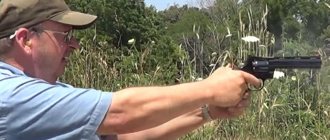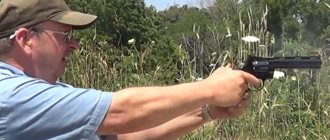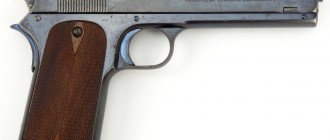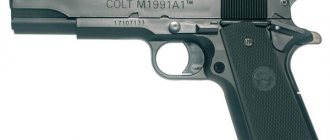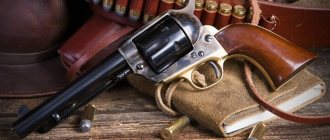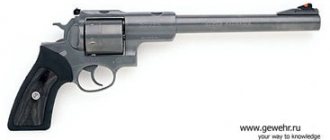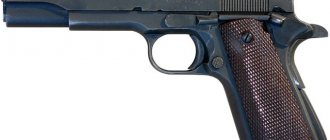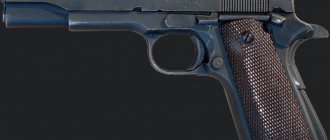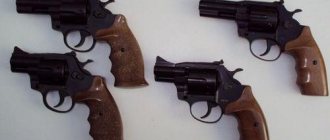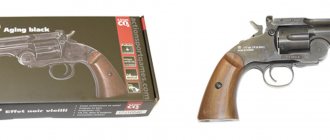Single action revolver type
| 1851 Colt Navy Revolving Pistol | |
| Colt 1851 Navy revolver pistol | |
| Type | Single action revolver |
| Place of origin |
|
| Service history | |
| In service | 1851–1878 |
| Used |
|
| Wars | List
|
| Production history | |
| Designer | Samuel Colt |
| Designed by | 1850 |
| Manufacturer | Colt's Patent Firearms Manufacturing Company, Hartford, Connecticut. |
| Produced | 1851–1873 |
| No. built | 272 000 |
| Options | Squareback Navy Trigger Guard Serial Number 1 - c. 4200 |
| Characteristics | |
| Weight | 2.6 lb (1.2 kg) |
| Length | 13 inches (330 mm) |
| Cartridge | .38 Rimfire/.38 Centerfire (conversions) |
| Caliber | 0,36 |
| Action | Single action revolver |
| starting speed | 840 ft/s (256 m/s) |
Colt revolving pistol belts
or
Navy pistol
, sometimes erroneously called the "Colt reverse belt pistol Navy Caliber" or "Navy Caliber" (Navy heavy pistol and Navy Size Caliber was named later for another Colt model), is cap and ball revolver, which was designed by Samuel Colt between 1847 and 1850.
Colt first called this revolver the Ranger Size
and then the Revolving Belt, but the "Navy" name quickly took over.
After the Civil War, revolvers with fixed metal cartridges became widespread. The Colt Navy remained in production until 1873, when it was replaced in the Colt line by what would become one of the manufacturer's most famous pistols, the Colt Single Action Army (also known as the Peacemaker
and
Colt 45
).
The total number of Colt 1851 Navy Revolvers produced was exceeded only by the Colt Pocket models, which were in parallel development, and numbered approximately 215,000 domestic units and approximately 42,000 produced at the Colt London Armory. [4]
Characteristics[edit]
The six-cartridge .36-caliber Navy revolver was much lighter than modern Colt Dragoon revolvers, which were developed from the .44 Walker Colt revolvers of 1847, which, given their size and weight, were typically carried in saddle holsters. [5] This is a larger version of the .31 caliber Colt Pocket Percussion revolver, which was descended from the earlier Baby Dragoon, and like them, is a mechanically improved and simplified descendant of the 1836 Paterson revolver. As the factory designation suggests, the Navy revolver was the correct size to be worn in a belt holster. It became very popular in North America during the Western expansion. Colt's aggressive promotion spread the Navy and his other revolvers throughout Europe, Asia and Africa.
The cylinder of this revolver is engraved with a scene from the Second Texas Fleet's victory at the Battle of Campeche on May 16, 1843. The Texas Navy acquired an earlier Colt Paterson revolver, but this was Colt's first major success in the weapon. trade; The naval theme of the engraved cylinder of the Colt 1851 Navy revolver was a gesture of Colt's appreciation. The engraving was provided by Waterman Ormsby. [6] Despite the "Navy" designation, the revolver was purchased primarily by civilians and ground military personnel. [7]
The .36 caliber (0.375–0.380 in) round lead ball weighs 80 grains and, at 1,000 fps, is comparable in power to a modern .380 pistol cartridge. Loads consist of loose powder, ball or bullet, metal foil cartridges (early) and flammable paper cartridges (Civil War era), all combinations ignited by a lightning strike cap attached to nipples at the rear of the chambers.
A very small number of Navy revolvers were produced in .34 caliber and are marked as such. Another rarity in 1851 Navy production is the .40 caliber model, only 5 of which were produced in 1858 for testing by the US Bureau of the Navy.
The sight rib consists of a conical front sight with a brass cone pressed into the muzzle end of the top plane of the barrel with a notch in the top of the hammer, as in most Colt percussion revolvers. Despite the relative crudeness of the sighting system, these revolvers and their modern copies are generally quite accurate.
Businessman
However, all this time, Colt's weapons were gradually gaining their way into life. Shortly before the first bankruptcy, the inventor sold a small batch of Patterson revolvers to a group of Texas Rangers - militiamen who defended the Republic of Texas from Mexicans and Indians. Bands of resourceful Indians managed to break through the barrage, rushing at the soldiers while they reloaded their muskets. Colt's invention allowed riflemen to neutralize Indian tactics. Samuel Walker, a Ranger captain, sent Colt a letter of thanks praising his pistols. “If they are further improved,” he wrote, “they will become the most advanced weapons in the world.” According to Walker's account, a unit of 15 soldiers armed with revolvers dealt with a band of 80 Comanches.
Colt Pocket Model 1849 1. Barrel. 2. Drum. 3. Trigger. 4. Frame. 5. Trigger. 6. Spring. 7. Handle. 8. Handle pads. 9. Charging lever plunger. 10. Charging lever. 11. Trigger guard.
Colt 1851 Naval conversion[edit]
The first metallic cartridge revolver made by Colt was the Thuer-Conversion Model Revolver, whose design did not require a cylinder chambered so as not to infringe Rollin White's patent. A small number (about 1,000–1,500) of Navy Model 1851 revolvers were converted using front-loading cartridges, slightly tapered to fit cylinder chambers flared to a slight cone.
Following the expiration of Rollin White's patent (April 3, 1869), the Colt 1851 (and 1861 Navy) revolvers were converted or remanufactured to fire the .38 rimfire or centerfire cartridge, the Colt Model 1851 Richards-Mason Conversion
at the Colt plant.
Industrialist
Colt model 1903 pocket hammerless
The gun's reputation in Mexico and good reviews from owners in Florida and Texas outweighed concerns about novelty and unreliability. The government ordered another thousand copies, and in 1847 Colt, borrowing money from a banker relative, hired workers and opened his own small production facility in Hartford, capable of producing up to 5,000 pistols a year.
In 1849, Colt made the best personnel decision of his life. He lured Elisha Root, who was considered the most experienced engineer in New England, from another company. By the end of the year, the plant, built under the leadership of Ruth, was already producing a hundred pistols a week.
When Colt went to exhibit in London in 1851, he was an international celebrity. Its Hartford plant employed 300 people and produced approximately 20,000 pistols per year. The extremely popular .31 caliber pocket pistol was added to the line of models, the demand for which was so great that the plant could barely cope with production. Colt traveled around European capitals in search of new buyers for his pistols. In 1852, he founded a factory in London, becoming the first American entrepreneur to open a branch of his production overseas.
1911 Colt M1911 Semi-automatic .45 caliber pistol
As the owner of the largest privately owned gun manufacturing company in the world, Colt managed to extend the life of some key patents and maintained a monopoly in the field, and the events that unfolded over the next decade were simply a gunsmith's dream come true. The US victory over Mexico opened the way to the southwest. In those wild places, complete anarchy reigned, which created a huge demand for revolvers. Gold rushes in California and Australia added new crowds of buyers. Sales also increased due to the Crimean War of 1853-1856.
Use [edit]
Notable users of the "fleet" included Wild Bill Hickok, William Buffalo Bill Cody, John Henry "Doc" Holliday, Richard Francis Burton, Ned Kelly, Bully Hayes, Ben Pease, Blackbirds, Metis, Seth Kinman, Emir Abdelkader, Richard H. Barter , Charlie Goodnight, Robert E. Lee, Nathan B. Forrest, John O'Neill, Frank Gardiner, Ulysses S. Grant, Quantrill's Raiders, Tom Bell, Kootenay Brown, Ivan Turchin, John Coffey "Jack" Hayes, Bigfoot Wallace, Frederick Townsend Ward, Ben McCulloch, Addison Gillespie, John "Rip" Ford, "Sul" Ross and most of the pre-Civil War Texas Rangers. [8] [9] [10] [11] Use continued long after more modern cartridge revolvers were introduced.
The Ottoman Empire used the revolver during the Russo-Turkish War of 1877–1878, although it was quite obsolete compared to the Russian Smith & Wesson Model 3.
The fictional film character "The Man with No Name" also used a Navy transformation in the film "The Good, the Bad and the Ugly".
- Flammable paper cartridges; six in a box
- Safety pin between cylinder chambers
- Colt revolvers after 1851
- Loading sequence for percussion revolvers
- Early Colt Navy Mod 1851, Model 2 square trigger guard
- Colt Navy 51, engraved by Gustav Young
- Above: Navy 51 .38 Conversion, below Colt Model 1871-72 Open Top
- A pair of Colt 1851 Navy sent Abraham Lincoln to Emir Abdelkader for protecting Christians in the 1860 grief of the Lebanese Civil War.
Businessman
However, all this time, Colt's weapons were gradually gaining their way into life. Shortly before the first bankruptcy, the inventor sold a small batch of Patterson revolvers to a group of Texas Rangers - militiamen who defended the Republic of Texas from Mexicans and Indians. Bands of resourceful Indians managed to break through the barrage, rushing at the soldiers while they reloaded their muskets. Colt's invention allowed riflemen to neutralize Indian tactics. Samuel Walker, a Ranger captain, sent Colt a letter of thanks praising his pistols. “If they are further improved,” he wrote, “they will become the most advanced weapons in the world.” According to Walker's account, a unit of 15 soldiers armed with revolvers dealt with a band of 80 Comanches.
Colt Pocket Model 1849 1. Barrel. 2. Drum. 3. Trigger. 4. Frame. 5. Trigger. 6. Spring. 7. Handle. 8. Handle pads. 9. Charging lever plunger. 10. Charging lever. 11. Trigger guard.
Links[edit]
- https://collections.museumvictoria.com.au/items/387913
- https://russianrevolvers.com/rp3a.html
- https://s3-eu-west-1.amazonaws.com/eu.storage.safecreative.org/1/2014/06/15/00000146/9e2d/4daf/2a56/ef9fb15a75cc/GaribaldinosysusArmas.pdf?response-content - type = application% 2Fpdf & X-Amz-Algorithm = AWS4-HMAC-SHA256 & X-Amz-Date = 20180730T081136Z & X-Amz-SignedHeaders = host & X-Amz-Expires = 86400 & X-Amz-Credential% =% = 1SXTY4DX4G6BJ-1SXTY4DX4G6JF-1SXTY4DX4G6J1 % 2Faws4_request & X-Amz-Signature = 1d7a0cd87238f75e6899ae3a18e8d0baa5282bfc253980d3593038d45cf2345e
- Wilson, R.L. Colt: An American Legend. NY; London, page 78
- Hounshell, David A. From the American System to Mass Production, 1800–1932
, p. 47 - Chicoine, David (10 June 2005). Guns of the New West: A Close Up to Modern Replica Firearms. Iola: Krause Publications. paragraph 50. ISBN 0-87349-768-6.
- Hounshell, David A. From the American System to Mass Production, 1800–1932
, p. 47 - ↑
Norris, Whale Australia Heritage Album, page 161 - ↑
Herring, Hal, Notable Firearms of the Old West: From Wild Bill Hickok's Colt Revolvers to Geronimo's Winchester, p. 21 - Roberts, Gary L. Doc Holliday: The Life and Legend. John Wiley and Sons, page 54
- https://www.imdb.com/title/tt11445842/?ref_=ttep_ep4
Eh, once again...
At the beginning of the 18th century, when using firearms, a very troublesome reloading process was required after each shot, which turned into a deadly weakness on the battlefield. Gunsmith designers have been experimenting with multi-barreled weapons since the very first days of the use of gunpowder in warfare, but such weapons were heavy and inconvenient. In Collier's Model 1813 revolver, it was not the barrels that rotated, but only the breech (it had to be turned manually before each shot), but by design, the gunpowder in each chamber was ignited by a flintlock, which created a spark by striking the flint on the iron. The weapons revolution began in 1799, when the British chemist Edward Howard discovered that mercury fulminate (“mercuric fulminate”) was an excellent initiating explosive, and in 1805, the Scottish priest Alexander John Forsyth first used mercury fulminate balls to ignite gunpowder at trigger strike. In 1814, mercury fulminate began to be placed in steel, and in 1818 - in copper capsule caps, which were placed on fire tubes that conducted fire to gunpowder. The new system quickly replaced the old flint designs. Colt's percussion revolver used a cylinder with five or six powder chambers. A powder charge and a bullet were inserted into each of them, and primers were inserted into the ignition holes of each chamber. The chambers were reloaded from the front, for which a small cleaning rod was used, which was traditionally attached directly to the pistol under the barrel. What was new was that when cocking the hammer, a special pawl rotated the drum until the charging chamber completely coincided with the barrel, and in this position the drum was fixed. When the shooter pulled the trigger, under the action of a spring, the trigger hit the primer, which ignited the powder charge, the gases from which pushed the bullet. The next time the hammer was cocked, a new charging chamber was brought to the barrel, and the revolver was ready for the next shot. Five (or six) bullets could be fired in a matter of seconds, providing a significant advantage when facing multiple opponents. He didn’t want to return to a sailor’s life, and Colt started selling laughing gas, which he learned to produce from a chemist in Ware. For three years he toured the United States and Canada under the name “Dr. Coult of New York, London and Calcutta,” pushing a handcart in front of him and showing audiences the effects of nitrous oxide. Earnings reached $10 a day, which was not bad for the 1830s. However, Colt did not forget about his idea. With the money he earned, he hired a gunsmith from Baltimore, John Pearson, who brought the design of the revolver to perfection.
Colt Navy 1851 Six Shot .36 Caliber Percussion Revolver
In 1835, Samuel, borrowing a thousand dollars from his father, went to Europe and patented a revolver in England and France, and in 1836 received an American patent number 138, after which he persuaded his cousin Dudley Selden and several other investors from New York to invest $200 000 to his Patent Arms Manufacturing Company in Patterson, New Jersey, which soon began producing five-shot Patterson Model .36 single-action revolvers (thumb-cocked). Colt himself began selling and advertising his weapons. Realizing that government patronage would be the key to success, he rushed to Washington to make contacts at the federal level. He was confident that hospitable parties and bribes to the right people would quickly open the eyes of the authorities to the merits of his invention. Cousin Dudley, looking at the liquor bills, grumbled: “I doubt the old Madeira will improve the performance of the new weapon.”
Colt Army 1860 Six Shot .44 Caliber Percussion Revolver
Bibliography[edit]
- Bates, Johnny; Cumpston, Mike (2005). Percussion pistols and revolvers: history, characteristics and practical use
. Lincoln, NE: iUniverse. - Burton, Sir Richard Francis (2003). First steps in East Africa
. University of Adelaide Library. - Herring, Hal (2008). Famous Firearms of the Old West: From Wild Bill Hickok's Colt Revolvers to Geronimo's Winchester, Twelve Guns That Shaped Our History
. Globe Pequot. ISBN 978-0-7627-4508-1. - Hounshell, David A. (1984), From the American System to Mass Production, 1800–1932: The Development of Manufacturing Technology in the United States
, Baltimore, MD: Johns Hopkins University Press, ISBN 978-0-8018-2975-8, LCCN 83016269. OCLC 1104810110 - Keith, Elmer (1956). Sixguns: The Standard Reference
. New York: Bonanza Books. - Norris, Keith (1990). Australian Heritage Sketchbook
. PR Books. ISBN 978-1-875113-37-8. - Roberts, Gary L. (2011). Doc Holliday: The Life and Legend
. John Wiley and Sons. ISBN 978-1-118-13097-1. - Wilson, R.L. (1985). Colt: An American Legend
. NY; London: Atabras, a division of the Abbeville publishing group. - Jordan, Robert M. Colt 1851 and 1861 Naval Forces and Conversions
.
Preface
Pneumatic weapons chambered for the so-called “air cartridge” (originally “air-cartridge”) have a very strange fate in Russia. For the first time, such weapons appeared en masse in the Russian Federation in the mid-1990s, then in the early 2000s they also suddenly disappeared from sale, then reappeared and disappeared again. The last turn of this spiral in my memory took place in the second half of the 2000s, when in St. Petersburg the “Soldier of Fortune” store imported a number of models of pistols for “air-cartridge” at very inhumane price tags, and even then, after some time, these pistols were no longer on sale disappeared again, and a criminal case was opened against the importer (as I understand, it was subsequently successfully closed, because the store continues to operate).
One way or another, there are perhaps several thousand copies of various models of such weapons in circulation on the territory of the Russian Federation, mainly from Cuno Melcher. The most common is the ME-38 revolver in various variations. Most often found in the ME-38 Magnum version, with an explicitly or implicitly sawn drum. Several times there was mention of a modification of the ME-38 Competition, and once I even almost bought a strange hybrid: it seemed to be the same ME-38 Competition, but with a very long barrel and a wooden butt, something like a carbine for border guards from Nagana. Once again I had the opportunity to hold in my hands an ME-9 pistol, externally made to look like a Walther PPK pistol, and I also heard several times about having the ME Single Action Army model in my hands, but until recently I was not able to personally get acquainted with this model. But there were a lot of rumors about it, in particular, for example, it was credited with being made of steel (as opposed to the light alloy ME-38 Magnum) and for this reason very easy to convert into a firearm.
One way or another, when I saw an advertisement for the sale of such a revolver, I could not pass by and purchased it at a very reasonable price, not much higher than the price of the much more common ME-38 Magnum. I have never regretted the purchase - the thing is extremely interesting and pleasant. Along with the revolver itself, cartridges and pump, the seller gave me a certificate for this model, from which it follows that in May 2004, as many as 30 copies of such revolvers were brought to Moscow. Considering that at that time I was already closely interested in the subject of air guns, I can say with confidence that this model was not in more or less popular stores. Either it was dismantled very quickly, or it was originally brought to order and simply did not make it into open sale. In any case, now I have this very interesting model and this is what the rest of the story will be about.
Relevant Python Features
If you look at the Colt Python drawing, you will notice a number of specific design parts.
- The internal bore of the barrel is polished using a special technology and is evenly tapered along the entire length of the barrel towards the bullet exit hole. This feature forces the bullet to gently enter the rifling, which significantly increases shooting accuracy.
- Automatic safety with the ability to completely block the trigger when the trigger is not fully pressed.
- An elongated casing for the extractor rod of spent cartridges running under the barrel, reaching the muzzle.
- A bar located above the barrel with special holes for cooling and ventilation of the barrel.
- Improved double action trigger mechanism.
- The open sights have an adjustable rear sight and brightening inserts suitable for use in the dark of the day.
- The inertial firing pin is located specifically in the pistol frame.
Highly accurate, high-quality Colt Python is suitable for self-defense, hunting, targeted shooting and concealed carry.
Tactical and technical properties of the model
There are four modifications of the Python family, the main difference of which is the barrel length. All barrel length options: 64 mm, 102 mm, 153 mm, 203 mm.
- The barrel has 6 left-hand rifling.
- The most powerful cartridge used is .357 Magnum.
- Drum with a capacity of 6 cartridges.
- The initial departure speed is 410 m/s.
- Weight without cartridges in grams: 1006, 1077, 1233, 1386.
Marketing genius
Colt was one of the first entrepreneurs to master the arsenal of all the tools that can be used to promote a product to the market and to expand sales markets. The revolver was a new product, virtually unknown to the general public, so Colt diligently collected positive reviews from the lips of bureaucrats in the Ministry of Defense, soldiers who fought on the western borders, and pioneers exploring new territories. He did not have the patience to wait for laudatory reviews of his product in the press - so he wrote such reviews himself. When favorable materials appeared in the press, he ordered his agents: “Send me a hundred copies, and give the editor a revolver.” Engravers were constantly working at his factory, preparing gift revolvers for presentation to government officials, state governors and anyone else, as long as he was involved in lucrative contracts. He was one of the first to master what later turned into a standard method of behavior in the market - advertising campaigns, discount sales, persistent promotion of “new” products and even street stands
He was one of the first to accompany his products with a “user’s manual,” which was especially important for those who were initially intimidated by the novelty and complexity of the revolver. Walker needed the upgraded pistols as soon as possible
However, although Colt remained the owner of the revolver patent, he no longer had his own manufacturing base. He agreed with Eli Whitney, the owner of a musket factory located in Connecticut, to produce a batch of weapons. Six months later, the order was completed, and Captain Walker, who was constantly rushing Colt, received a pair of revolvers named after him four days before his death in battle.
